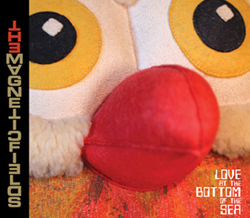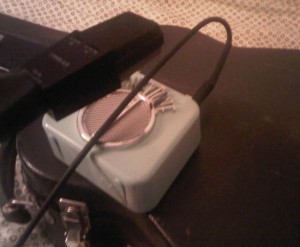Behind The Release: The Magnetic Fields’ Love at the Bottom of the Sea
On March 6th, The Magnetic Fields are slated to release Love at the Bottom of the Sea. It will be a return to form for the band and for their primary member, the absurdist songwriter and Morrissey-sound-alike Stephin Merritt.

Pre-order via Merge Records
After releasing 1999’s critically acclaimed 69 Love Songs, Merritt decided to abandon the drum machines and synthesizers that had been such a key part of the The Magnetic Field’s sound, and started to set his often-comic, sometimes-maudlin, and always-deadpan performances to a backdrop of exclusively acoustic instruments instead.
With Love at the Bottom of the Sea, the synths are back, and the production sounds more streamlined than ever before. As always, the main attraction remains Merritt’s unmistakable two-and-a-half minute wry pop gems.
We talked to longtime Magnetic Fields engineer Charles Newman about what’s like to work with a songwriter who’s known for self-recording, and for a personal style that earns him regular comparisons to Eyeore.
Recording The Magnetic Fields
“Without trying to speak for Stephin,” Newman said over coffee near his SoHo production studio, “I think the last three albums were intended as a kind of synth-less trilogy.”
Newman, who was a synthesis major at Berklee, says he “learned the art of recording Marshall stacks” in the 90s with New York Hardcore bands like H20, Breakdown, and Madball. But he didn’t need either of those skill-sets to work on 2003’s elegant-sounding i, 2008’s fuzz-sonnet Distortion, or the very folky Realism in 2010.
“Even on Distortion, where the whole record is just covered with all these fuzzed-out sounds, a lot of it was done on acoustic instruments,” he says.
And for all the fuzz, the loudest guitar amp they used much of the time was miniature cigarette-box amp, taped to Stephin’s pant-leg. It pointed up into to his guitar to give him feedback.
“Every single instrument we recorded had feedback on it,” Newman says. “Even on the acoustic piano, we had this little Fender Princeton pointing straight into the soundboard to give it some feedback.”
Walls of Synthesizers
On Love at the Bottom of the Sea, tracking began at Merritt’s home in L.A., and when the synths came back, they came back with a vengeance.
“Over the past 30 years, [Merritt] had been collecting synths and drum machines. Ever since he moved to LA and got a bigger space, they just started piling up faster. Now when you walk in there it’s just walls and walls of synths stacked up all around.”
“He had all of these great analog synthesizers – the Swarmatron and the Dewanatron; a Moog Rogue and [a Voyager]; a rack with all these little modules. He really wanted to start using all those.”
Merritt would begin creating rhythm tracks on his own, using drum machines, samplers and by even creating percussion patches inside some of his analog keyboards and modules. Newman, who helped put together Merritt’s home studio in LA, would stop by to help from time to time.
“I think he managed to use every synth in the place at least once. I mean, maybe a couple things didn’t get used, because there were so many of them, but we were really trying to diversify the sounds as much as possible. And I think it probably made him feel good, after buying them all, to know he got to use each one – even if it was just on one little sound,” he laughs.
From there, the sessions came back to New York City where the bi-coastal Newman keeps a personal production room in a SoHo loft. He used to maintain a full-fledged commercial studio called Mother West nearby, but since the lease ran out, he’s been bouncing around from studio to studio, and doing a lot of work from a home studio, too.
“As a freelance producer I can just go wherever, and I like that. Everyone in LA is pretty much that way too. It seems that everybody out there has a studio in their garage, but hardly anyone runs commercial studios anymore. And the people that do? They all work their asses off trying to pay bills because you can only charge so much these days, you know?” Although he might not too interested in running his own commercial space anymore, he still enjoys using them whenever the budget allows it.
Guitars, Big and Small
Newman tracked most of the acoustic instruments on Bottom of the Sea at his personal space in SoHo, and did some of the guitars there as well, using a tiny Danelectro Honeytone amplifier that he likes for tracking.
“Stephin brought all these cool effects boxes and boutique phaser pedals and things with him. We’d do all this crazy stuff, like put the amp under a glass bowl and put a mic on it. For each guitar we’d get two different signal paths and create some really interesting sounds,” he says.
But for some of the parts, he says bigger amps and higher volumes were in order. “We did a guitar tracking at Serious Business too. For modest budgets I’ll go there a lot. On bigger-budget sessions, I often wind up at Downtown Music or Germano Studios.”
They also spent a day in San Francisco at John Vanderslice’s Tiny Telephone recording studio.
Newman says he likes mixing on a console like Tiny Telephone’s vintage Neve when he can, but for Bottom of the Sea, they used his own DAW-based system.
Mixing
“Stephin has a lot of outboard gear at his place, and we’d print a lot of effects using those: old reverbs, Orbans, and a nice old Pultec filter that we’d pump a lot of things through. We were always trying things and printing what we liked. I’d suggested the idea of mixing live on a desk and getting the inserts going, but in the end we needed to have the mix recall instead. Really, it’s just easier.
“To be honest though, I didn’t really use a lot of plug-ins on [the album]. I have the [Waves] SSL 4000 bundle and you can ask a lot of them without sucking up too much juice [on your computer]. They’re very clear and they make it easy to really clean things up.
“So that was a lot of it. I was adding some clarity to the tracks using the SSL plug-ins, and using a Neve summing amp to open things up a little bit too. I just got their summing amp, the 8816 recently, and that made a big difference on the record, I think. That thing just sounds awesome.”
If a person wanted to get a sense for just how far the quality of affordable gear has come over the years, listening to the latest Magnetic Fields album against their earliest recordings would be a pretty good place to start. While their first records sounds charmingly hazy, Bottom of the Sea sounds charming, simply because the songs are.
Listen to the advance single “Andrew in Drag” off Love at the Bottom of the Sea:
The Magnetic Fields – Andrew in Drag by MergeRecords
The gear has made the process simpler too. In 1999, already a decade into the band’s career, Newman first teamed up with The Magnetic Fields to help complete the tracking sessions for 69 Love Songs. He remembers zipping back and forth from Merritt’s home studio to his own commercial room with an armload of ADAT tapes. Today, Newman and Merritt use the same type of speakers at each of their homes, a pair of Dynaudio nearfields, and of course, file transfers are a lot simpler as well. Newman completes much of the mixing on his own, and then brings Merritt in for the final touches.
“One day, Stephin came by and listened to the entire record all the way through. I told him: ‘Don’t say anything – Just listen, and you can tell me at the end.’ When it was over, he had about ¾ of a page of comments. Little things like ‘Bass drum too loud?’ or ‘Tamborine down a db?’. That was all. We made a couple of tweaks and sent it off to mastering. It was one of the smoothest processes of all time.”
Please note: When you buy products through links on this page, we may earn an affiliate commission.








Jeran
February 28, 2012 at 4:22 pm (13 years ago)Somebody needs a proofreader. Also: MORRISSEY SOUND-ALIKE? Please. There is NOTHING even remotely similar between the two vocalists, aside from both being great.
TrustMeI'mAScientist
March 5, 2012 at 10:44 pm (13 years ago)Typos do occasionally slip through even our steely-eyed editors, but I’ll take responsibility for them being there in the first place.
If you see any specific typos, please feel free to bring them to the attention of the editors or authors via email.
As for the Morrissey comparison, I’ll have to assume you’re being sarcastic. 😀
I love Merritt for sounding like a quirky cross between Morrissey and Eore, and I’ll stand by that statement to the grave.